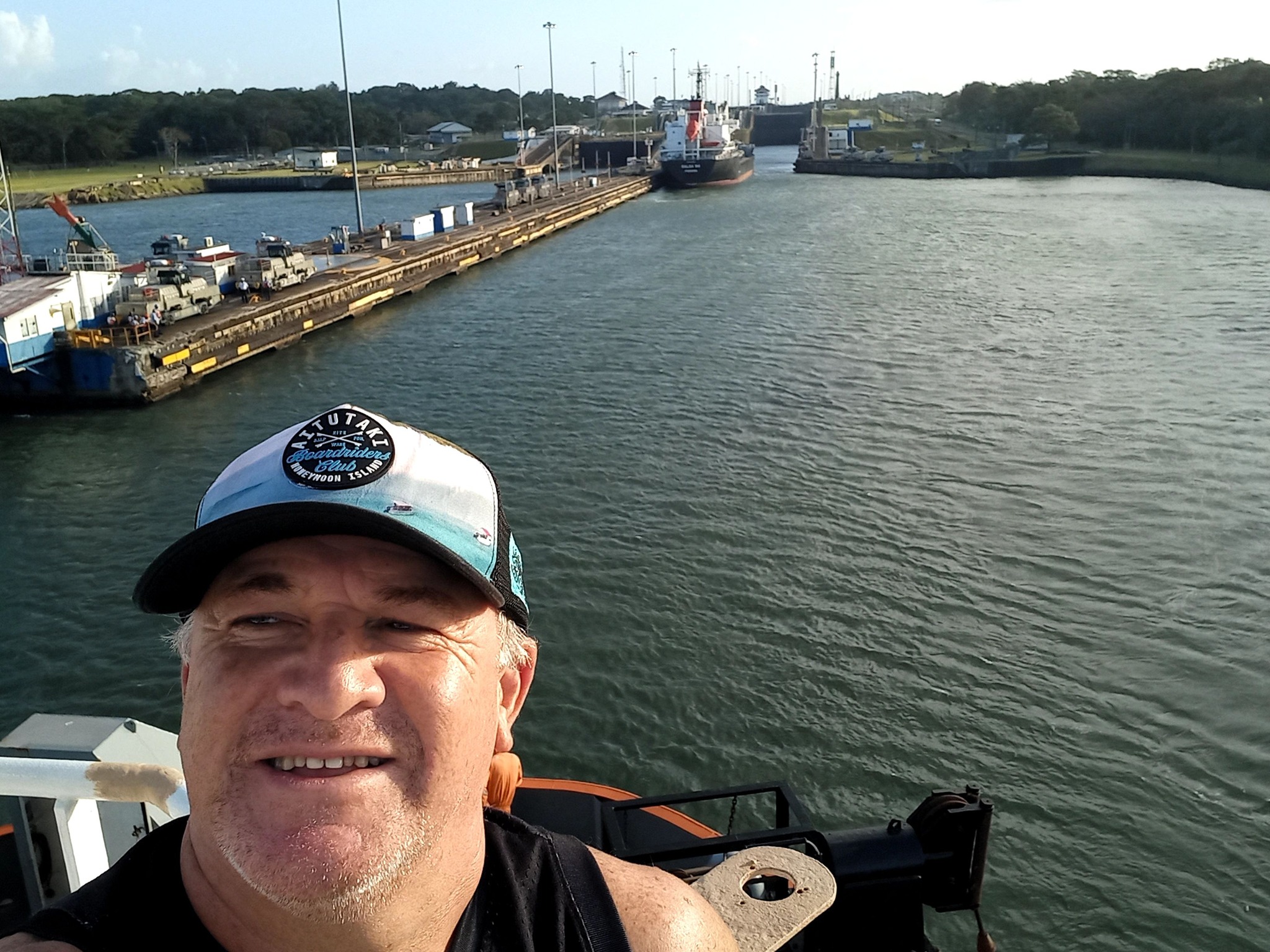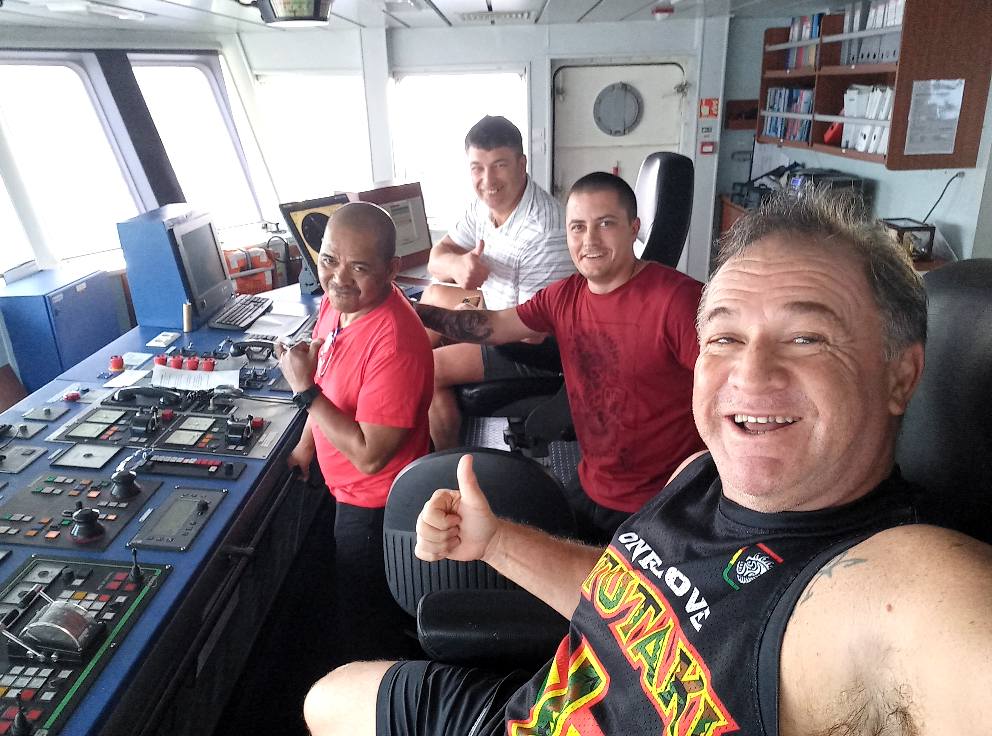The opportunity of a lifetime: Trip through Panama Canal
Saturday 4 March 2023 | Written by Joanne Holden | Published in Features, Weekend

Paul Lynch at Panama Canal. PAUL LYNCH/23030331
A Cook Islander who hitched a ride on the Anuanua Moana as it sailed from the southern United States, over rough seas in the Gulf of Mexico, and through the Panama Canal has described the voyage as akin to ‘getting a chance to go to the moon’. Joanne Holden reports.
The longest boat trip Paul Lynch had ever embarked on before his recent “adventure” was from Rarotonga to Aitutaki.
Lynch earned a spot on the boat through his previous role as Seabed Minerals Commissioner, a position he occupied for seven years before stepping down in 2019.
“My job was to prepare the relationships with good companies, and the rules and regulations for safe mineral sector development,” Lynch says.
“The exploration phase has kicked off, but I’m not involved anymore.”
Lynch believes the new Commissioner, Alex Herman, is “doing awesomely” because she follows the same principles he did while in the role: taking care, and ensuring decisions benefit the Cook Islands and the environment.
Lynch continues: “These companies, they still know me – and the men who I dealt with, their wives all made friends with my wife. When I was in the conferences, they’d go out doing spouses events like visit temples; go shopping; go to restaurants. They made great friends.”
So, it was wife Shona who first received an invite for the “lifetime opportunity”.
“Shona says, ‘No way.’
“She hangs up, and I’m sitting here and I say, ‘What was that about? What about me?’
“It was hearing the words ‘Panama Canal’. Even though I never thought I wanted to do it, as soon as I heard about it, it was like getting a chance to go to the moon.”
The invitation was to accompany his wife’s friend and her husband, Moana Minerals chief executive Han Smit, from the southern United States to Panama on the company’s 1485-tonne exploration vessel bound for the Cook Islands.
“I was doing it as a geek. I love seeing how things work,” Lynch says.
Lynch flew out of Rarotonga on January 2 and boarded the vessel while it was out of the water for its “dry dock phase” in Galveston, Texas a few days later.

Paul Lynch at the Space Center Houston in Texas. PAUL LYNCH/23030329
Over the next two weeks, Lynch watched as the boat was transformed from an oil industry offshore support vessel to an exploration boat.
“I said, ‘Show me everything.’ They showed me the engine, the laboratory on board, the water column sampler. During my time as Seabed Minerals Commissioner, I knew these things were part of exploration, but I’d never seen them,” Lynch says.
Lynch also travelled into the township a number of times to sample the restaurants, art galleries, and other tourist spots.
Once the vessel’s transformation was complete, it eased back into the water and sailed into the Gulf of Mexico.
“It was like action stations for the next four, five days. They were trialling all the things they’d put on board – and everyone’s on edge because if it doesn’t work or something breaks, it can cost tens of thousands of dollars,” Lynch says.
“The sea got up from just one metre to four metres, so for two or three days these waves were coming over the bow of the boat, but it still had to keep doing its work.
“I just stayed out of the way and observed what was going on.”
Lynch was surprised by how strong his sea legs were as the boat barrelled through aggressive waters.
“I didn’t get sick. Other people would come down in the morning looking grey, and they hadn’t slept, but I’d still be able to eat my normal big breakfast,” he says.
“Because I’m from the Cook Islands, they said it must be my voyager side coming out.”
The vessel headed back to Galveston to refuel after it was determined “everything worked”, before turning towards Panama and sailing into the gulf again, where the crew faced even more rough weather.
“The boat would go up and then boom, the nose would go in the water and water would splash over the bridge,” Lynch says.
Internet was patchy at sea so Lynch started reading novels, knocking out close to four novels in the two weeks he was at sea.
“I haven’t read novels in 20 years because online and Facebook takes up my extra time. It was amazing, because I’d almost forgotten what novel-reading was like,” he says.
“I was halfway through the last one when we got to Panama City, and I’m still finishing it.”
When the vessel reached the Panama Canal, there were about 100 boats waiting to pass through.

Paul Lynch with bridge crew members of Anuanua Moana. PAUL LYNCH23030332
The Anuanua Moana began its voyage through the canal about three hours later, Lynch says.
“There was a big vessel in front of us. The two of them went through the one lock together and when they close it off, it’s amazing.
“They have 10 Panamanian linesmen, all in uniform, throw a line that attaches to the side of each vessel. There’re two locomotives at the front, two at the back, and they have steel cables – so these linesmen pull the cable over, attach it to the ship, and then the ship can’t move to the side so it stops it smashing into the side.
“The ship is under its own engine, just at two or three knots, slowly going through. Then they stop it, they close the lock, and the boat lifts up 20 metres. They open the front one, and both vessels get pulled through by those locomotives. Overall, I think it goes up 60 metres in three lots.”
Lynch says the vessel then sails into a lake, before being dropped down 40 metres into the Pacific Ocean.
“It was fascinating.”
It was past midnight when, about 10 hours after reaching the canal, the vessel came out the other side.
“I was still awake because I wanted to see it all,” Lynch says.
He was on a plane to Houston a few hours later, while the vessel headed to Tahiti to refuel before embarking on the final leg of its journey to the Cook Islands, where it would be carrying out seabed minerals exploration over the next five years.
Lynch landed back in the Cook Islands on February 24.
He had since reconnected with some of the vessel’s crew, showing them around his island home.
Lynch’s trip was funded by money he made through his business, Paul’s Rarotonga Hot Sauce












































